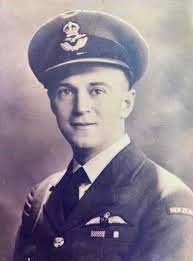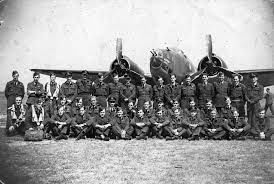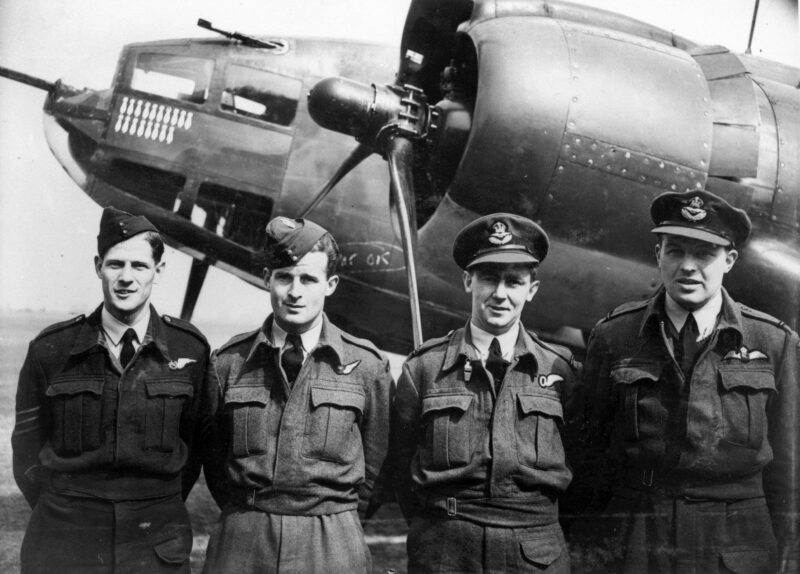Stories
Stories
Remembering the Quiet Stories: 487 Squadron
A focus for NZBCA has increasingly become to share the stories of those who served in Bomber Command as their children, grand-children and other family members have sought to learn more of what this generation of airmen experienced. Here, NZBCA member Sally Crook shares the story not only of her grandfather Greg Whitwell, but of many of the brave men he served alongside on 487 (NZ) Squadron.
No. 487 may not have the profile of the other NZ Bomber squadron, 75 (NZ), yet the men who flew the light bombers were no less brave, and, given the aircraft they flew, it could be argued they took on even greater danger. Service in Bomber Command was not a competition. All who flew were remarkable young men, volunteers tasked with challenging missions requiring enormous bravery. As Sally says, we must not forget to tell the quiet stories. They often belong to the ones who sacrificed the most.

F/O Gregory Francis Whitwell, DFM
(Credit: Whitwell family)
I never got to meet my grandad. But I have always felt connected to him somehow despite this. I remember very clearly the first time my mum told me the story of how Grandad earned his Distinguished Flying Medal during the war.
I was in primary school, and we were learning about family trees. I must have been about seven. We were in the dining room, and I was sitting in Dad’s spot doing my homework. I had to make a family tree and include who Mum and Dad’s parents and siblings were.
And while it was probably not the first time I had heard about Grandad; it was the first time that I had heard about the war and how brave he was.
My grandad was Greg Whitwell, an RNZAF pilot with 487 Squadron in Britain. Mum told me that Grandad had been badly hurt, but he flew his plane home with one arm and got to meet the King at Buckingham Palace.
I was an introverted little thinker even then, and I remember pondering over this story for a long time afterwards. I remember looking at the newspaper article that Mum had, from 1943, and there was a miniature medal that I was lucky enough to take to school so I could tell my class about how brave my grandad was. We lived next door to the school, and I think Mum escorted the medal to and from school for show and tell one morning.
Years later, I now have a much better understanding of the story of Grandad’s DFM. He was one of the early members of 487 Squadron, arriving at Feltwell with his crew in September 1942.
He was with 487 Squadron for seven months, until he was wounded. On the 20th of April 1943 Grandad was flying Ventura ‘W for Willie’ on an operation to the Outreau Marshalling Yards in Boulogne. On the approach to their target, the cockpit was hit by an anti-aircraft shell, shattering Grandad’s upper left arm.
Somehow, he managed to keep flying, the crew dropped their bombs in the target area, and they turned for home. Knowing they would not make it back to Methwold, they diverted to Lympne. Grandad made a forced landing there – with one arm, and one engine on fire.
I sometimes wonder what it would have been like inside that aircraft on the way home. If there is one thing that I have learnt about bomber crews, it is that they would have all been helping each other.
At the time, 1 Squadron was based at Lympne. Amongst the daily happenings and tales of flying latrines, Betty Grable, and WAAF’s in swimming pools, there is an entry in the 1 Squadron record book describing their landing.
“The bomber made two circuits of the aerodrome while the crew trimmed the aircraft and finally made a remarkably good landing. This despite the fact the pilot had a compound fracture of his left arm and had lost a considerable amount of blood and was lifted out of the aircraft in a semi- conscious state. It was unanimously agreed that this was a damn good show.”
Other accounts also have him putting out the fire with the extinguisher. Grandad was the first member of 487 to be decorated. His DFM nomination credits him with saving the lives of his crew.
He spent the next 12 months in and out of hospitals recovering. It seems awful to think of such a horrible thing as a blessing, but when I look at it with all the information that I now have – that injury likely saved his life.

Group of No. 487 Squadron personnel in front of a Ventura. Believed to be at RAF Station Feltwell.
(Credit: Air Force Museum of New Zealand / Andrew Coutts collection)
Only two weeks later, his squadron were to suffer horrendously on the operation ‘Ramrod 17’. This raid is well known. On the 3rd of May 1943, 12 crews from 487 Squadron would leave Methwold at 16:43, the target being a power station in Amsterdam.
One crew returned to base with a faulty escape hatch shortly after take-off. The rest of the story becomes a gut-wrenching tragedy. One by one, the remaining crews were shot down and only one Ventura returned home.
Of the 44 men who had successfully departed Methwold, only four made it back to England. And only two back to base. 28 men lost their lives and 12 were taken prisoner of war. The one Ventura that made it home was badly damaged, with two crew members severely wounded. They would later end up in hospital with Grandad.
All the crew were deservedly awarded either the DFC or the DFM, and Squadron Leader Leonard Trent whose story has been widely told was later awarded the Victoria Cross.
It is hard to imagine exactly what it would have felt like for those at Methwold – waiting, hoping and then knowing that those crews were not coming home. All of them – the ground crew, the airmen, the support staff, senior officers, and my grandad, had lost 40 of their friends. Even Wing Commander Grindell was “ordered to bed, too much work has got him down.”
I recently bought a second handbook, and inside it were a few old newspaper clippings. One of them mentioned the story of Ivan Urlich, whose life was saved by his crew. Wanting to know more about this I started looking and found numerous examples of heroism amongst these eleven crews. And I wondered, why don’t we hear about them more? I still have much to learn, but now when I see this operation mentioned in articles and books I think of it very differently.
I think of Andrew Coutts, and William Goodfellow – lost over the ocean and not found. I think about what might have happened in the moments leading up to that. I think of Jack Sharp. I think of him trying to bail out of his burning aircraft and not being able to get through the escape hatch. He was the only one of his crew to survive.
I think of Stuart McGowan and Ivan Urlich. I think of McGowan and Canadian observer Ernest Thornber, scrambling to get their wounded friend and air gunner Ivan Urlich into his parachute and then pushing him out of their aircraft. Saving his life first and intending to follow, but not being able too. And I think of the crew’s wireless operator, Cyril Smith, a kind man from Miller’s Flat.
I think of pilot Terry Taylor, fighting with a destroyed Ventura to make a crash landing in a garden, with burnt hands, and his controls on fire. Although all were injured, three out of four of this crew survived – quite possibly owing to his skill in crash landing their aircraft.
I think of Owen Foster. Giving all he had to fly with the nose of his aircraft blown off and the rest barely holding together, trying to give his crew the best chance possible. I think of Tom Penn and Tim Warner.
I think of Tom Penn battling desperately to hold onto his mortally wounded friend as the plane crashed, and then sank in the sea. And I think of him and Foster, and their wireless operator, all injured, trying to stay afloat for hours afterward until eventually being picked up by a boat and sent to a prisoner of war camp. There is a quote from one of them describing what it was like struggling to stay alive, alone in the ocean. It sticks in my brain.

Owen Foster and his crew, with their Ventura.
L-R: Sergeant R.W. Mann (RAAF), Sergeant T.W.J Warner, Flying Officer T.A. Penn and Flying Officer O.E. Foster.
(Credit: RNZAF Official).
I think of Thomas Baynton, a mechanic from Auckland. He had completed four months service with 21 Squadron before being posted to 487 Squadron and this would be his eleventh op with them. He and his crew all lost their lives on this operation.
I think of Stanley Peryman, known as ‘Rusty.’ On a previous mission his aircraft had come down in the sea. He had been the only one of his crew to survive and he too had spent hours in the sea waiting for rescue. After a few days in hospital, he returned to base and just a month after this ordeal he was back on operations. Peryman and his crew did not survive on the operation to Amsterdam. They are buried next to Stuart McGowan and Cyril Smith.
I think of Stanley Coshall. He is always smiling in photographs. He had served in two other squadrons before joining 487. Two of his crew have remarkable stories of survival. One of them reported seeing Stanley opening his escape hatch as the Ventura burned and broke up in the sky, but he did not survive.)
I think of the one crew that made it back to England. I think of Johnnie Starkie, and Laurence Neill -who was badly injured himself, caring for their severely wounded crew mate Alan Turnbull, putting out fires, and trying to free some of the bombs that were still trapped in the plane. And I think of Arthur Duffill. Fighting to get the four of them home in a barely flyable Ventura, utterly ruined but still loaded with bombs – jammed in place and threatening to explode on a rough landing.
And for those men who did not get back, but managed to survive that first round of horror, I think of the further inhumanities they had to endure as prisoners of war. There are plenty of names that I have not mentioned here, and they will all have their own stories that are just as important as these ones. Sadly, there are many that were never able to be told.
It is unfortunate that younger generations such as mine miss out on learning all the details of these sorts of stories sometimes. In a fast-paced world people only want the headlines. If you go looking for them, you will find them – lesser told stories of extraordinary bravery and selfless dedication to others. But not everyone goes looking. And so, I wanted to try and write something to honour my grandad’s friends, so that they too can keep being remembered for how brave they were that day.
We must not forget to tell the quiet stories. They often belong to the ones who sacrificed the most.
Sally Crook, 2024
With thanks to the following references:
Laurence Neill, Errol Martyn, H.L Thompson, David Palmer and Aad Neeven, Max Lambert, Alex van der Wetering,
Aircrew Remembered (Website),
Commonwealth War Graves Commission,
487 & 1 Squadron Operations Record Books – National Archives, Kew.